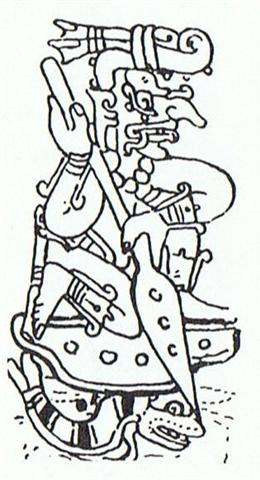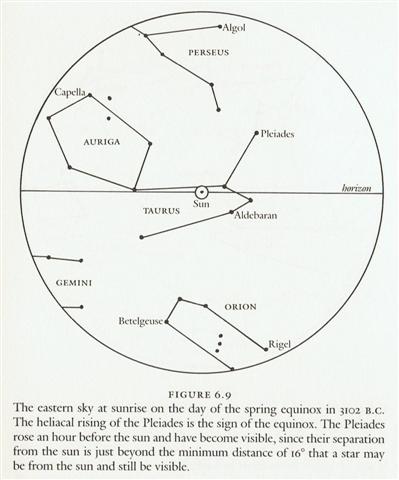3. The first group of 64 days ends where the text turns from side b to side a, where there ought to be an open mouth as a sign for the 'birth' of a new great 'world':
When Alice's hedgehog is going through an arch it means the hog is being 'reborn' into next 'square' in time. To be born is to be pushed through a hole. But at the beginning of side a there is no such hole (pu). Instead the holes are 'plugged' or 'hilled up' (puo in Gb8-30). A pair of 'mouths' (in Ga1-1 and Ga1-4) are open towards the sky, signs of light returning above (cfr at Kuukuu). Vaha mea, 'the red opening' (in Sunday), presumably implies Sun is returning. Though not by entering through a hole, he is rather arriving by canoe over the 'sea', as depicted in the first of the Rain God images:
In myth the colour 'red' is mainly used symbolically. I think this 'red' indicates the powerful (redhot) phase of a new fire, cfr the canoe-shaped tao glyph type:
Both Aldebaran (perhaps depicted in Ga1-4) and Mars are 'red'. According to Allen the colour of Aldebaran is pale rose, while according to my elementary astronomy book Mars is orange yellow. Orange is the colour of fire. My conviction of mythic 'red' signifying powerful is mainly based on the following in Kelley's Deciphering the Maya Script: "... F÷rstemann recognized 584 days as a remarkably close approximation to a Venus year, with inferior conjunction calculated as 8 days, and identified a glyger which recurred in all the columns associated with this calculation as the name for Venus. In all these calculations, this glyph has the prefix which has been identified as chac 'red, great', and a Yucatec name for Venus is Chac Ek 'Great Star'. Thompson (1950, p. 218) shows that Great Star is a common Maya designation of Venus in several different languages, although the particular words meaning 'great' are different, as are the particular words meaning 'star'. It would seem fairly obvious that, if the glyger for Venus consisted of the 'great' glyph and another glyph, and the name for Venus is Great Star, then the second glyph should mean simply 'star', probably Yucatec ek 'star' or kanal 'star'. Strangely enough, however, the second glyph, has, instead, been taken to mean 'Venus', wherever it occurs. It is possible that Venus was considered 'the star' par excellence (if no prefixes are present). Thompson (1950, p. 229) notes that 'Venus glyphs in the inscriptions are not reviewed in detail because there is full evidence that no pattern of significance will emerge whatever correlation is used.' This seems easily understandable, if glyphs which do not refer to Venus at all, but rather to other planets of constellations, have been included in the calculation ..." However, I also remember the Japanese word for baby, viz. aka-tyan = 'the little red one', which indicates a connection between the very young and the colour red. We can therefore guess this vaha mea indicates 'the great opening' of the mythical (far in the past) front side of the year. Once upon a time the rise of Aldebaran announced the beginning of summer (north of the equator) and similarly the rise of Antares meant the end of summer:
We are led to the conclusion that the front side of the G text contains a structure defined by stars which are (or rather once were) rising together with Sun in summer north of the equator. Today on Easter Island these stars can still be observed in the nights and depending on where among them Full Moon is located it will be known where (in which sign) Sun - in the opposite part of the sky roof - is currently moving, i.e. which time it is in the solar year (cfr at Camp 5):
The minimum distance from Sun for a star to be visible is 16║ Worthen says. This could explain why the first 16 glyphs in a line evidently is of another kind than those from number 17. Number 16 is an aspect of Jupiter, 'Father Light', which implies that number 17 should be connected with his powerful new Son (maybe inside Venus as moring star). Glyph line a1 is not only the first in the text but also number 17 (if we go on counting past line b8). If we imagine Sun has 10 months with 30 days in each, then half of this time could be summer and the other half winter. With Ana-mua (Antares) at the beginning of summer Al Nā'ir would then be at its end:
Ha˙ in Gb2-17 has 7 + 12 = 19 'feathers', which could indicate 19 months (covering 18 * 20 + 5 = 365 days or maybe 18 * 20 + 4 = 364 days). If we divide 336 by 2 the result is 168 (12 fortnights) which could be significant. The summer wife of Rehua was Ruhi-te-ragi (cfr at Ruhi): 
In Kelley's Deciphering the Maya Script he has pointed out that there are distance numbers of 168 days between each of the pictures in a zodiac in the Paris Codex. These intervals served to put the consecutive constellations on opposite sides of the sky roof rather than next to each other:
The central figure on page 23 presumably is the same creature as the 'water serpent' which the Rain God has under his canoe when he arrives - we can see that their tails are drawn alike. |
|||||||||||||||||||||||||||||||||||||||||||||||||||||||||||||||||||||||||||||||||||||||||||||||||||||||












